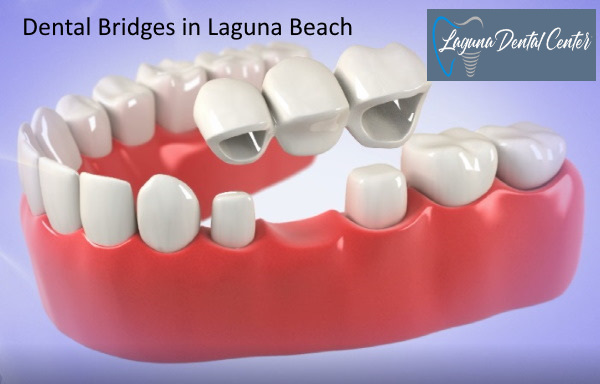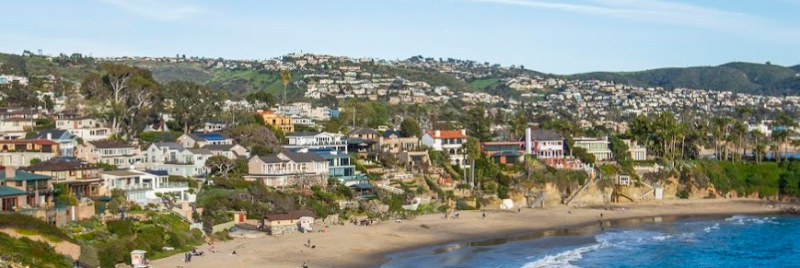Table of Contents

Laguna Dental Center Dental Bridge for Laguna Beach Community
A dental bridge is a custom-made replacement tooth consisting of false teeth or teeth held in place by the abutment on the adjacent side of the gap. A dental bridge permanently replaces missing teeth with false teeth. Dr. Ronald Ayzin DDS at Laguna Dental Center has been treating patients with dental bridges procedure since 2017. Dental bridges can last for 10 years, as published by the American Dental Association. Contact us if you have questions about the cost of dental bridges near Laguna Beach, California. Do you want to know if you should have a dental bridge? A dental bridge replaces one or more lost teeth and prevents the cheeks and lips from becoming deformed.
We are near you. Schedule an appointment by calling (949) 704-6269.
Am I a Candidate for Dental Bridges in Laguna Beach?
You are a good candidate for a dental bridge if you have at least one missing tooth that has either fallen out or has been extracted. You should also have two strong and healthy teeth on both sides of the gap where the teeth are missing.
- You should have good oral health. There shouldn’t be any dental work to be done in the future before this treatment.
- You should have strong teeth on both sides of the missing teeth. The supporting teeth should not need dental treatment in the future since it can lose its strength over time, making them unsuitable for this procedure.
- Your jawbone density should be healthy enough to support a dental implant.
- You should be free from periodontal disease. If you have gum disease, you must treat it before doing this procedure.
How long do dental bridges last?
Bridges have an average lifespan of 10 to 30 years, depending on the state and health of the teeth and rest of the mouth, as well as the patient’s dental hygiene and maintenance practices. Dental bridges, according to the University of Rochester Medical Center, can endure 10 years or more with adequate care and maintenance. A dental bridge work conducted by a professional with the competence and abilities required to complete the treatment at the highest level has a better likelihood of success and longevity.
How much do Dental Bridges Cost in Laguna Beach?
Dental bridges typically cost between $1200 and $3000 per bridge. The abutments and pontics are included in the price.
- The cost of a traditional bridge ranges from $1200 to $5000.
- The cost of Maryland bridges ranges from $1,200 to $2,500.
- The cost of an Implant-supported bridge ranges from $4,500 to $15,000.
How much do dental bridges cost without insurance in Laguna Beach?
The cost of bridges without insurance is determined by a variety of variables. The cost of replacing a lost tooth is influenced by the complexity of the treatment and ranges from $75 and $200 based on several factors such as the following below.
- Location
- Anesthetic if required
- Complexity
- Number of teeth needed to fill the gap
Does dental insurance cover Dental Bridges in Laguna Beach?
The cost of a dental bridge with insurance depends on the materials used. An all-porcelain bridge is more expensive than metal or porcelain-fused bridge. Some insurance companies may cover a portion of the entire cost based on the need, but you may have to pay for at least some of the cost Laguna Beach.
How much do dental implant bridges cost in Laguna Beach?
The cost for a dental bridge ranges from ; depending on the type of bridge you select. The treatment charge for traditional teeth bridge typically costs between for a pontic and a crown for each abutment tooth. The cost of Maryland teeth bridges charged by a practice that offer them can vary between for one pontic. This can be cheap because dental insurance covers tooth bridges—the cost of an all-porcelain bridge is more than that of a metal or porcelain-fused bridge.
Additional fees may include:
- Diagnostic costing
- Exam
- Digital X-ray
- Treatment options
- Aftercare
Why choose Dental Bridges treatment with Dr. Ronald Ayzin at Laguna Dental Center near Laguna Beach?
For dental bridges treatment at Laguna Beach, CA, Laguna Dental Center is the best choice. Here’s why.
Our office is equipped with state-of-the-art technology, including 3D imaging software, allowing our experts to design bridges with pinpoint accuracy. After reviewing your information, Dr. Ronald Ayzin will create a treatment plan to help with your bridges. Dr. Ronald Ayzin has helped over 200 patients with bridges. We have reasonably priced bridges that are tailored to your budget and schedule. birds
With Laguna Dental Center, your search for dental bridge treatment near Laguna Beach, CA can end here. Make an appointment to see what your smile will look like after bridge treatment. Look at our patients’ testimonials to see about us why we are the best option for bridges.
Make an Appointment with Dr. Ronald Ayzin at Laguna Dental Center for Dental Bridges
Dr. Ronald Ayzin at Laguna Dental Center provides the best quality dental bridges at a cost that our neighbors near Laguna Hills can afford.
Call us at (949) 704-6269 to schedule an appointment.
- FREE Dental Bridge Smile Consultation ($100 Value)
- FREE Digital X-rays, especially for Tooth Bridge ($150 Value)
- We Maximize your Insurance, so you pay less out of pocket.
Make an Appointment with Dr. Ronald Ayzin for Dental Bridges Consultation near Laguna Beach
Contact Us:
What are Dental Bridges?
A tooth bridge is a fixed dental treatment that consists of two or more crowns on each side of the gap that are kept in place by the abutment teeth and an artificial tooth or teeth in between. Pontics are fake teeth constructed of gold, alloys, porcelain, or a mix of these materials. Dental bridges are supported by natural teeth or implants.
What are types of dental bridges?
There are four types of dental bridges: traditional, cantilever, Maryland, and implant-supported.
- Traditional Bridge. A traditional dental bridge comprises an artificial tooth or teeth that are kept in place by dental crowns that are bonded onto each abutment tooth. The most common form of dental bridge is a conventional bridge, which can be utilized when you have natural teeth on both sides of the gap left by your missing tooth.
- Cantilever Bridge. A conventional bridge is identical to a Cantilever dental bridge. Nonetheless, in a cantilever dental bridge, the pontic is kept in place by a dental crown affixed to only one abutment tooth. A cantilever bridge requires only one natural tooth next to the missing tooth gap.
- Maryland Dental Bridge. Like a typical bridge, a Maryland dental bridge uses two natural abutment teeth, one on each side of the gap. On the other hand, a standard bridge puts dental crowns on the abutment teeth, and a Maryland bridge uses a framework of either metal or porcelain attached to the backs of the abutment teeth. Like a standard bridge, a Maryland bridge may only be utilized if you have a natural tooth on either side of the gap produced by the missing tooth or teeth.
- Implant-supported Bridge. Dental implants are used in implant-restrained bridges rather than crowns or frames. One implant is surgically implanted for each lost tooth to hold the bridge in place. If one implant for each missing tooth is not viable, the bridge may have a pontic hanging between implant-supported crowns.
How do dental bridges work?
A dental bridge typically requires two dentist visits. This operation must be performed by dentists or dental experts in a dental clinic.
- Your dentist will reshape your abutment teeth at your initial session. The enamel and dentin will be removed to create a way for the crown.
- Your teeth will be photographed or digitally scanned by your professional. A dental laboratory will use the scan or model to construct a bridge, fake teeth, and crowns. To protect the exposed regions of your mouth, you’ll wear a temporary bridge until your permanent bridge is ready.
- Your dentist will remove the temporary bridge and replace it during your second visit. Your professional will inspect the bridge and make any required changes.
What do dental bridges look like?
A dental bridge, similar to how a bridge spans a chasm to connect two pieces of land, stretches over a gap caused by one or more missing teeth to reconnect the surrounding teeth. Simply put, a dental bridge looks like a row of teeth.
About Laguna Beach

Historically settled by Paleoindians, the Tongva people, and then Mexico, the location became part of the United States following the Mexican–American War. Laguna Beach was settled in the 1870s, officially founded in 1887, and in 1927 its current government was incorporated as a city. The city adopted the council–manager form of government in 1944. The city has remained relatively isolated from urban encroachment by its surrounding hills, limited highway access, and dedicated greenbelt. The Laguna Beach coastline is protected by 5.88 miles (9.46 km) of state marine reserve and an additional 1.21 miles (1.95 km) of state conservation area.
Tourism is the primary industry with an estimated six million people visiting the community annually. Large annual events include the Pageant of the Masters, Festival of Arts, Sawdust Art Festival, Art-A-Fair, Bluewater Music Festival, and Kelpfest.
In October 1993, a fire in Laguna Beach destroyed or damaged 441 homes and burned more than 14,000 acres (5,700 ha). The National Fire Protection Association listed it as the seventh-largest loss wildland fire in the United States.
According to the United States Census Bureau, the city of Laguna Beach has a total area of 25.4 km2 (9.8 sq mi), of which 22.9 km2 (8.8 sq mi) are land and 2.5 km2 (0.97 sq mi) are covered by water. Its coastline is 7 mi (11 km) long and includes 27 beaches and coves. It is bordered by the Pacific Ocean on the southwest, Crystal Cove State Park and the city of Newport Beach on the northwest, Laguna Woods on the northeast, Aliso Viejo and Laguna Niguel on the east, and Dana Point on the southeast.
The land in and around Laguna Beach rises quickly from the shoreline into the hills and canyons of the San Joaquin Hills. The town’s highest point, at an elevation of 1,007 feet (307 m), is Temple Hill in the Top of the World neighborhood. Because of its hilly topography and surrounding parklands, few roads run into or out of town; only the Coast Highway connecting to Newport Beach to the northwest and to Dana Point to the south, and State Route 133 crossing the hills in a northeastern direction through Laguna Canyon. Parts of Laguna Beach border the Aliso/Wood Canyons Regional Park.
The 2010 United States Census reported that 22,723 people, 10,821 households, and 5,791 families resided in the city. The population density was 2,313.8 inhabitants per square mile (893.4/km2). The 12,923 housing units averaged 1,315.9 per square mile (508.1/km2).
According to an analysis by NeighborhoodScout.com, Laguna Beach has a higher crime rate than the national average of communities of all population sizes in the United States. The chance of becoming a victim of a violent crime is 1 in 200 and of a property crime is 1 in 36.
Laguna’s foothill trails are known internationally for mountain biking. Mountain bike hall of fame legend Hans Rey makes his home in Laguna Beach, as do the Rads, pioneers of mountain biking going back to the 1970s. Source: (Wikipedia)
Dental Bridges Near Me in Laguna Beach

